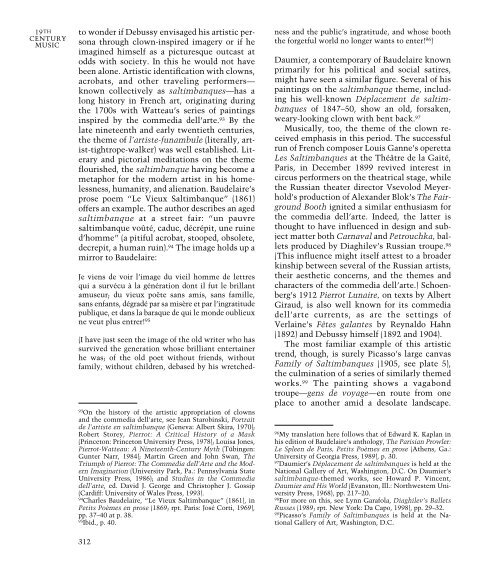Parisian Cake Walks.pdf - ResearchSpace@Auckland
Parisian Cake Walks.pdf - ResearchSpace@Auckland
Parisian Cake Walks.pdf - ResearchSpace@Auckland
You also want an ePaper? Increase the reach of your titles
YUMPU automatically turns print PDFs into web optimized ePapers that Google loves.
19TH<br />
CENTURY<br />
MUSIC<br />
to wonder if Debussy envisaged his artistic persona<br />
through clown-inspired imagery or if he<br />
imagined himself as a picturesque outcast at<br />
odds with society. In this he would not have<br />
been alone. Artistic identification with clowns,<br />
acrobats, and other traveling performers—<br />
known collectively as saltimbanques—has a<br />
long history in French art, originating during<br />
the 1700s with Watteau’s series of paintings<br />
inspired by the commedia dell’arte. 93 By the<br />
late nineteenth and early twentieth centuries,<br />
the theme of l’artiste-funambule (literally, artist-tightrope-walker)<br />
was well established. Literary<br />
and pictorial meditations on the theme<br />
flourished, the saltimbanque having become a<br />
metaphor for the modern artist in his homelessness,<br />
humanity, and alienation. Baudelaire’s<br />
prose poem “Le Vieux Saltimbanque” (1861)<br />
offers an example. The author describes an aged<br />
saltimbanque at a street fair: “un pauvre<br />
saltimbanque voûté, caduc, décrépit, une ruine<br />
d’homme” (a pitiful acrobat, stooped, obsolete,<br />
decrepit, a human ruin). 94 The image holds up a<br />
mirror to Baudelaire:<br />
Je viens de voir l’image du vieil homme de lettres<br />
qui a survécu à la génération dont il fut le brillant<br />
amuseur; du vieux poëte sans amis, sans famille,<br />
sans enfants, dégradé par sa misère et par l’ingratitude<br />
publique, et dans la baraque de qui le monde oublieux<br />
ne veut plus entrer! 95<br />
(I have just seen the image of the old writer who has<br />
survived the generation whose brilliant entertainer<br />
he was; of the old poet without friends, without<br />
family, without children, debased by his wretched-<br />
93 On the history of the artistic appropriation of clowns<br />
and the commedia dell’arte, see Jean Starobinski, Portrait<br />
de l’artiste en saltimbanque (Geneva: Albert Skira, 1970);<br />
Robert Storey, Pierrot: A Critical History of a Mask<br />
(Princeton: Princeton University Press, 1978); Louisa Jones,<br />
Pierrot-Watteau: A Nineteenth-Century Myth (Tübingen:<br />
Gunter Narr, 1984); Martin Green and John Swan, The<br />
Triumph of Pierrot: The Commedia dell’Arte and the Modern<br />
Imagination (University Park, Pa.: Pennsylvania State<br />
University Press, 1986); and Studies in the Commedia<br />
dell’arte, ed. David J. George and Christopher J. Gossip<br />
(Cardiff: University of Wales Press, 1993).<br />
94 Charles Baudelaire, “Le Vieux Saltimbanque” (1861), in<br />
Petits Poèmes en prose (1869; rpt. Paris: José Corti, 1969),<br />
pp. 37–40 at p. 38.<br />
95 Ibid., p. 40.<br />
312<br />
ness and the public’s ingratitude, and whose booth<br />
the forgetful world no longer wants to enter! 96 )<br />
Daumier, a contemporary of Baudelaire known<br />
primarily for his political and social satires,<br />
might have seen a similar figure. Several of his<br />
paintings on the saltimbanque theme, including<br />
his well-known Déplacement de saltimbanques<br />
of 1847–50, show an old, forsaken,<br />
weary-looking clown with bent back. 97<br />
Musically, too, the theme of the clown received<br />
emphasis in this period. The successful<br />
run of French composer Louis Ganne’s operetta<br />
Les Saltimbanques at the Théâtre de la Gaité,<br />
Paris, in December 1899 revived interest in<br />
circus performers on the theatrical stage, while<br />
the Russian theater director Vsevolod Meyerhold’s<br />
production of Alexander Blok’s The Fairground<br />
Booth ignited a similar enthusiasm for<br />
the commedia dell’arte. Indeed, the latter is<br />
thought to have influenced in design and subject<br />
matter both Carnaval and Petrouchka, ballets<br />
produced by Diaghilev’s Russian troupe. 98<br />
(This influence might itself attest to a broader<br />
kinship between several of the Russian artists,<br />
their aesthetic concerns, and the themes and<br />
characters of the commedia dell’arte.) Schoenberg’s<br />
1912 Pierrot Lunaire, on texts by Albert<br />
Giraud, is also well known for its commedia<br />
dell’arte currents, as are the settings of<br />
Verlaine’s Fêtes galantes by Reynaldo Hahn<br />
(1892) and Debussy himself (1892 and 1904).<br />
The most familiar example of this artistic<br />
trend, though, is surely Picasso’s large canvas<br />
Family of Saltimbanques (1905, see plate 5),<br />
the culmination of a series of similarly themed<br />
works. 99 The painting shows a vagabond<br />
troupe—gens de voyage—en route from one<br />
place to another amid a desolate landscape.<br />
96 My translation here follows that of Edward K. Kaplan in<br />
his edition of Baudelaire’s anthology, The <strong>Parisian</strong> Prowler:<br />
Le Spleen de Paris, Petits Poèmes en prose (Athens, Ga.:<br />
University of Georgia Press, 1989), p. 30.<br />
97 Daumier’s Déplacement de saltimbanques is held at the<br />
National Gallery of Art, Washington, D.C. On Daumier’s<br />
saltimbanque-themed works, see Howard P. Vincent,<br />
Daumier and His World (Evanston, Ill.: Northwestern University<br />
Press, 1968), pp. 217–20.<br />
98 For more on this, see Lynn Garafola, Diaghilev’s Ballets<br />
Russes (1989; rpt. New York: Da Capo, 1998), pp. 29–32.<br />
99 Picasso’s Family of Saltimbanques is held at the National<br />
Gallery of Art, Washington, D.C.















